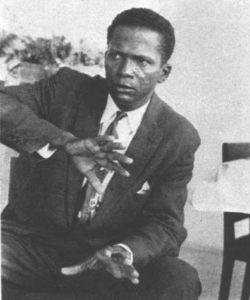Ladies and gentlemen, come and see. This isn’t a country here but an epic failure factory, an excuse for a place, a weed lot, an abyss for tightrope walkers, blindman’s bluff for the sightless saddled with delusions of grandeur, proud mountains reduced to dust dumped in big helpings into the cruciform maws of sick children who crouch waiting in the hope of insane epiphanies, behaving badly and swamped besides, bogged down in their devil’s quagmires. Our history is a corset, a stifling cell, a great searing fire.
— Lyonel Trouillot
What’s to be done about Haiti?
Generations have asked that question about the first and most intractable poster child for postcolonial despair, the poorest country in North or South America now and seemingly forever, a place whose corruption and futility manages to make the oft-troubled countries around it look like models of good governance. Nowhere feels James Joyce’s description of history as “a nightmare from which I am trying to awake” more apt. Indeed, Haiti stands as perhaps the ultimate counterargument to the idealistic theory of history as progress. Here history really is just one damned thing after another — differing slightly in the details, but always the same at bottom.
But why should it be this way? What has been so perplexing and infuriating about Haiti for so long is that there seems to be no real reason for its constant suffering. Long ago, when it was still a French colony, it was known as the “Pearl of the Caribbean,” and was not only beautiful but rich; at the time of the American Revolution, it was richer than any one of the thirteen British American colonies. Those few who bother to visit Haiti today still call it one of the most beautiful places of all in the beautiful region that is the Caribbean. Today the Dominican Republic, the nation with which Haiti shares the island of Hispaniola, is booming, the most popular tourist spot in the Caribbean, with the fastest-growing economy anywhere in North or South America. But Haiti, despite being blessed with all the same geographic advantages, languishes in poverty next door, seething with resentment over its condition. It’s as if the people of Haiti have been cursed by one of the voodoo gods to which some of them still pray to act out an eternal farce of chaos, despair, and senseless violence.
Some scenes from the life of Haiti…
…you are a proud Mandingue hunter in a hot West African land. But you’re not hunting. You’re being hunted — by slavers, both black and white. You run, and run, and run, until your lungs are near to bursting. But it’s no use. You’re captured and chained like an animal, and thrust into the dank hold of a sailing ship. Hundreds of your countrymen and women are here — hungry, thirsty, some beaten and maimed by your captors. All are terrified for themselves and their families, from whom they’ve been cruelly separated. Many die on the long voyage. But when it’s over, you wonder if perhaps they were the lucky ones…
The recorded history of the island of Hispaniola begins with the obliteration of the people who had always lived there. The Spanish conquistadors arrived on the island in the fifteenth century, bringing with them diseases against which the native population, known as the Taíno, had no resistance, along with a brutal regime of forced labor. Within two generations, the Taíno were no more. They left behind only a handful of words which entered the European vocabulary, like “hammock,” “hurricane,” “savanna,” “canoe,” “barbecue,” and “tobacco.” The Spanish, having lost their labor force, shrugged their shoulders and largely abandoned Hispaniola.
But in the ensuing centuries, Europeans developed a taste for sugar, which could be produced in large quantities only in the form of sugarcane, which in turn grew well only in tropical climates like those of the Caribbean. Thus the abandoned island of Hispaniola began to have value again. The French took possession of the western third of the island — the part known as Haiti today — with the Treaty of Ryswick, which ended the Nine Years War in 1697. France officially incorporated its new colony of Saint-Domingue on Hispaniola the same year.
Growing sugarcane demanded backbreaking labor under the hot tropical sun, work of a kind judged unsuitable for any white man. And so, with no more native population to enslave, the French began to import slaves from Africa. Their labor turned Saint-Domingue in a matter of a few decades from a backwater into one of the jewels of France’s overseas empire. In 1790, the year of the colony’s peak, 48,000 slaves were imported to join the 500,000 who were already there. It was necessary to import slaves in such huge numbers just to maintain the population in light of the appalling death toll of those working in the fields; little Saint-Domingue alone imported more slaves over the course of its history than the entirety of the eventual United States.
…you’re a slave, toiling ceaselessly in a Haitian cane field for your French masters. While they live bloated with wealth, you and your fellows know little but hardship and pain. Brandings, floggings, rape, and killing are everyday events. And for the slightest infraction, a man could be tortured to death by means limited only by his owners’ dark imaginations. What little comfort you find is in the company of other slaves, who, at great risk to themselves, try to keep the traditions of your lost homeland alive. And there is hope — some of your brothers could not be broken, and have fled to the hills to live free. These men, the Maroons, are said to be training as warriors, and planning for your people’s revenge. Tonight, you think, under cover of darkness, you will slip away to join them…
The white masters of Saint-Domingue, who constituted just 10 percent of the colony’s population, lived in terror of the other 90 percent, and this fear contributed to the brutality with which they punished the slightest sign of recalcitrance on the part of their slaves. Further augmenting their fears of the black Other was the slaves’ foreboding religion of voodoo: a blending of the animistic cults they had brought with them from tribal Africa with the more mystical elements of Catholicism — all charms and curses, potions and spells, trailing behind it persistent rumors of human sacrifice.
Even very early in the eighteenth century, some slaves managed to escape into the wilderness of Hispaniola, where they formed small communities that the white men found impossible to dislodge. Organized resistance, however, took a long time to develop.
Legend has it that the series of events which would result in an independent nation on the western third of Hispaniola began on the night of August 21, 1791, when a group of slave leaders secretly gathered at a hounfour — a voodoo temple — just outside the prosperous settlement of Cap‑Français. Word of the French Revolution had reached the slaves, and, with mainland France in chaos, the time seemed right to strike here in the hinterlands of the empire. A priestess slit the throat of a sacrificial pig, and the head priest said that the look and taste of the pig’s blood indicated that Ogun and Ghede, the gods of war and death respectively, wanted the slaves to rise up. Together the leaders drank the blood under a sky that suddenly broke into storm, then sneaked back onto their individual plantations at dawn to foment revolution.
That, anyway, is the legend. There’s good reason to doubt whether the hounfour actually happened, but the revolution certainly did.
…you are in the middle of a bloody revolution. You are a Maroon, an ex-slave, fighting in the only successful slave revolt in history. You have only the most meager weapons, but you and your comrades are fighting for your very lives. There is death and destruction all around you. Once-great plantation houses lie in smouldering ruins. Corpses, black and white, litter the cane fields. Ghede walks among them, smiling and nodding at his rich harvest. He sees you and waves cheerfully…
The proudest period of Haiti’s history — the one occasion on which Haiti actually won something — began before a nation of that name existed, when the slaves of Saint-Domingue rose up against their masters, killing or driving them off their plantations. After the French were dispensed with, the ex-slaves continued to hold their ground against Spanish and English invaders who, concerned about what an example like this could mean for other colonies, tried to bring them to heel.
In 1798, a well-educated, wily former slave named Toussaint Louverture consolidated control of the now-former French colony. He spoke both to his own people and to outsiders using the language of the Enlightenment, drawing from the American Declaration of Independence and the French Declaration of the Rights of Man and the Citizen, putting a whole new face on this bloody revolution that had supposedly been born at a voodoo houfour on a hot jungle night.
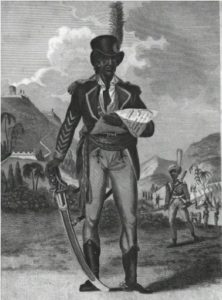
Toussaint Louverture was frequently called the black George Washington in light of the statesmanlike role he played for his people. He certainly looked the part. Would Haiti’s history have been better had he lived longer? We can only speculate.
…and you are battling Napoleon’s armies, Europe’s finest, sent to retake the jewel of the French empire. You have few resources, but you fight with extraordinary courage. Within two years, sixty thousand veteran French troops have died, and your land is yours again. The French belong to Ghede, who salutes you with a smirk…
Napoleon had now come to power in France, and was determined to reassert control over his country’s old empire even as he set about conquering a new one. In 1802, he sent an army to retake the colony of Saint-Domingue. Toussaint Louverture was tricked, captured, and shipped to France, where he soon died in a prison cell. But his comrades in arms, helped along by a fortuitous outbreak of yellow fever among the French forces and by a British naval blockade stemming from the wars back in Europe, defeated Napoleon’s finest definitively in November of 1803. The world had little choice but to recognize the former colony of Saint-Domingue as a predominately black independent nation-state, the first of its type.
With Louverture dead, however, there was no one to curb the vengeful instincts of the former slaves who had defeated the French after such a long, hard struggle. It was perfectly reasonable that the new nation would take for its name Haiti — the island of Hispaniola’s name in the now-dead Taíno language — rather than the French appellation of Saint-Domingue. Less reasonable were the words of independent Haiti’s first leader, and first in its long line of dictators, Jean-Jacques Dessalines, who said that “we should use the skin of a white man as a parchment, his skull for an inkwell, his blood for ink, and a bayonet for a pen.” True to his words, he proceeded to carry out systematic genocide on the remaining white population of Haiti, destroying in the process all of the goodwill that had accrued to the new country among progressives and abolitionists in the wider world. His vengeance cost Haiti both much foreign investment that might otherwise have been coming its way and the valuable contribution the more educated remaining white population, by no means all of whom had been opposed to the former slaves’ cause, might have been able to make to its economy. A precedent had been established which holds to this day: of Haiti being its own worst enemy, over and over again.
…a hundred years of stagnation and instability flash by your eyes. As your nation’s economic health declines, your countrymen’s thirst for coups d’etat grows. Seventeen of twenty-four presidents are overthrown by guile or force of arms, and Ghede’s ghastly armies swell…
So, Haiti, having failed from the outset to live up to the role many had dreamed of casting it in as the first enlightened black republic, remained poor and inconsequential, mired in corruption and violence, as its story devolved from its one shining moment of glory into the cruel farce it remains to this day. The arguable lowlight of Haiti’s nineteenth century was the reign of one Faustin Soulouque, who had himself crowned Emperor Faustin I — emperor of what? — in 1849. American and European cartoonists had a field day with the pomp and circumstance of Faustin’s “court.” He was finally exiled to Jamaica in 1859, after he had tried and failed to invade the Dominican Republic (an emperor has to start somewhere, right?), extorted money from the few well-to-do members of Haitian society and defaulted on his country’s foreign debt in order to finance his palace, and finally gotten himself overthrown by a disgruntled army officer. Like the vast majority of Haiti’s leaders down through the years, he left his country in even worse shape than he found it.
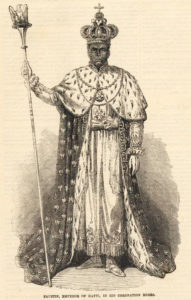
Haiti’s Emperor Faustin I was a hit with the middle-brow reading public in the United States and Europe.
…you are a student, protesting the years-long American occupation of your country. They came, they said, to thwart Kaiser Wilhelm’s designs on the Caribbean, and to help the Haitian people. But their callous rule soon became morally and politically bankrupt. Chuckling, Ghede hands you a stone and you throw it. The uprising that will drive the invaders out has begun…
In 1915, Haiti was in the midst of one of its periodic paroxysms of violence. Jean Vilbrun Guillaume Sam, the country’s sixth president in the last four years, had managed to hold the office for just five months when he was dragged out of the presidential palace into the street and torn limb from limb by a mob. The American ambassador to Haiti, feeling that the country had descended into a state of complete anarchy that could spread across the Caribbean, pleaded with President Woodrow Wilson to intervene. Fearing that Germany and its allies might exploit this chaos on the United States’s doorstep if and when his own country should enter the First World War on the opposing side, Wilson agreed. On July 28, 1915, a small force of American sailors occupied the Haitian capital of Port-au-Prince almost without firing a shot — a far cry from Haiti’s proud struggle for independence against the French. Haiti was suddenly a colony again, although its new colonizers did promise that the occupation was temporary. It was to last just long enough to set the country on its feet and put a sound system of government in place.
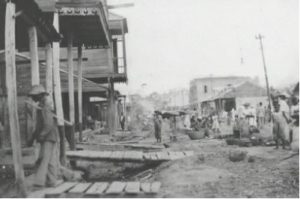
When the Americans arrived in Haiti, they found its people’s lives not all that much different from the way they had lived at the time of Toussaint Louverture. Here we see the capital city of Port-au-Prince, the most “developed” place in the country.
The American occupation wound up lasting nineteen years, during which the occupiers did much practical good in Haiti. They paved more than a thousand miles of roadway; built bridges and railway lines and airports and canals; erected power stations and radio stations, schools and hospitals. Yet, infected with the racist attitudes toward their charges that were all too typical of the time, they failed at the less concrete tasks of instilling a respect for democracy and the rule of law. They preferred to make all the rules themselves by autocratic decree, giving actual Haitians only a token say in goings-on in their country. This prompted understandable anger and a sort of sullen, passive resistance among Haitians to all of the American efforts at reform, occasionally flaring up into vandalism and minor acts of terrorism. When the Americans, feeling unappreciated and generally hard-done-by, left Haiti in 1934, it didn’t take the country long to fall back into the old ways. Within four years President Sténo Vincent had declared himself dictator for life. But he was hardly the only waxing power in Haitian politics.
…a tall, ruggedly handsome black man with an engaging smile.
He is speaking to an assembled throng in a poverty-stricken city neighborhood. He tells moving stories about his experiences as a teacher, journalist, and civil servant. You admire both his skillful use of French and Creole, and his straightforward ideas about government. With eloquence and obvious sincerity, he speaks of freedom, justice and opportunity for all, regardless of class or color. His trenchant, biting criticisms of the establishment delight the crowd of longshoremen and laborers.
“Latin America and the Caribbean already have too many dictators,” he says. “It is time for a truly democratic government in Haiti.” The crowd roars out its approval…
The aspect of Haitian culture which had always baffled the Americans the most was the fact that this country whose population was 99.9 percent black was nevertheless riven by racism as pronounced as anywhere in the world. The traditional ruling class was the mulattoes: Haitians who could credit their lighter skin to white blood dating back to the old days of colonization, and/or to the fact that they and their ancestors hadn’t spent long years laboring in the sun. They made up perhaps 10 percent of the population, and spoke and governed in French. The rest of the population was made up of the noir Haitians: the darker-skinned people who constituted the working class. They spoke only the Haitian Creole dialect for the most part, and thus literally couldn’t understand most of what their country’s leaders said. In the past, it had been the mulattoes who killed one another to determine who ruled Haiti, while the noir Haitians just tried to stay out of the way.
In the 1940s, however, other leaders came forward to advance the cause of the “black” majority of the population; these leaders became known as the noiristes. Among the most prominent of them was Daniel Fignolé, a dark-skinned Haitian born, like most of his compatriots, into extreme poverty in 1913. Unlike most of them, he managed to educate himself by dint of sheer hard work, became political at the sight of the rampant injustice and corruption all around him, and came to be known as the “Moses of Port-au-Prince” for the fanatical loyalty he commanded among the stevedores, factory workers, and other unskilled laborers in and around the capital. Fignolé emphasized again and again that he was not a Marxist — an ideology that had been embraced by some of the mulattoes and was thus out of bounds for any good noiriste. Yet he did appropriate the Marxist language of proletariat and bourgeoisie, and left no doubt which side of that divide he was fighting for. For years, he remained an agitating force in Haitian politics without ever quite breaking through to real power. Then came the tumultuous year of 1957.
…but you’re now a longshoreman in Port-au-Prince, and your beloved Daniel Fignolé has been ousted after just nineteen days as Provisional President. Rumors abound that he has been executed by Duvalier and his thugs. You’re taking part in a peaceful, if noisy, demonstration demanding his return. Suddenly, you’re facing government tanks and troops. Ghede rides on the lead tank, laughing and clapping his hands in delight. You shout your defiance and pitch a rock at the tank. The troops open fire, and machine-gun bullets rip through your chest…
One Paul Magloire, better known as Bon Papa, had been Haiti’s military dictator since 1950. The first few years of his reign had gone relatively well; his stridently anticommunist posturing won him some measure of support from the United States, and Haiti briefly even became a vacation destination to rival the Dominican Republic among sun-seeking American tourists. But when a devastating hurricane struck Hispaniola in 1954 and millions of dollars in international aid disappeared in inimitable Haitian fashion without ever reaching the country’s people, the mood among the elites inside the country who had been left out of that feeding frenzy began to turn against Bon Papa. On December 12, 1956, he resigned his office by the hasty expedient of jumping into an airplane and getting the hell out of Dodge before he came to share the fate of Jean Vilbrun Guillaume Sam. The office of the presidency, a hot potato if ever there was one, then passed through three more pairs of hands in the next six months, while an election campaign to determine Haiti’s next permanent leader took place.
Of course, in Haiti election campaigns were fought with fists, clubs, knives, guns, bombs, and, most of all, rampant, pervasive corruption at every level. Still, in a rare sign of progress of a sort in Haitian politics, the two strongest candidates were both noiristes promising to empower the people rather than the mulatto elites. They were Daniel Fignolé and François Duvalier, the latter being a frequent comrade-in-arms of the former during the struggles of the last twenty years who had now become a rival; he was an unusually quiet, even diffident-seeming personality in terms of typical Haitian politics, so much so that many doubted his mental fortitude and intelligence alike. But Duvalier commanded enormous loyalty in the countryside, where he had worked for years as a doctor, often in tandem with American charitable organizations. Meanwhile Fignolé’s urban workers remained as committed to him as ever, and clashes between the supporters of the two former friends were frequent and often violent.
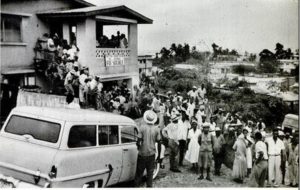
The workers around Port-au-Prince pledged absolute allegiance to Daniel Fignolé. He liked to call them his wuolo konmpresé — his “steamrollers,” always ready to take to the streets for a rally, a demonstration, or just a good old fight.
But then, on May 25, 1957, Duvalier unexpectedly threw his support behind a bid to make his rival the latest provisional president while the election ran its course, and Fignolé marched into the presidential palace surrounded by his cheering supporters. In a stirring speech on the palace steps, he promised a Haitian “New Deal” in the mold of Franklin D. Roosevelt’s American version.
The internal machinations of Haitian politics are almost impossible for an outsider to understand, but many insiders have since claimed that Duvalier, working in partnership with allies he had quietly made inside the military, had set Fignolé up for a fall, contriving to remove him from the business of day-to-day campaigning and thereby shore up his own support while making sure his presidency was always doomed to be a short one even by Haitian standards. At any rate, on the night of June 14, 1957 — just nineteen days after he had assumed the post — a group of army officers burst into Fignolé’s office, forced him to sign a resignation letter at gunpoint, and then tossed him into an airplane bound for the United States, exiling him on pain of death should he ever return to Haiti.
The deposing of Fignolé ignited another spasm of civil unrest among his supporters in Port-au-Prince, but their violence was met with even more violence by the military. There were reports of soldiers firing machine guns into the crowds of demonstrators. People were killed in the hundreds if not thousands in the capital, even as known agitators were rounded up en masse and thrown into prison, the offices of newspapers and magazines supporting Fignolé’s cause closed and ransacked. On September 22, 1957, it was announced that François Duvalier had been elected president by the people of Haiti.
Inside the American government, opinion was divided about the latest developments in Haiti. The CIA was convinced that, despite Fignolé’s worrisome leftward orientation, his promised socialist democracy was a better, more stable choice for the United States’s close neighbor than a military junta commanded by Duvalier. The agency thus concocted a scheme to topple Duvalier’s new government, which was to begin with the assassination of his foreign minister, Louis Raimone, on an upcoming visit to Mexico City to negotiate an arms deal. But the CIA’s plans accidentally fell into the hands of one Austin Garriot, an academic doing research for his latest book in Washington, D.C. Garriot passed the plans on to J. Edgar Hoover’s FBI, who protested strongly that any attempt to overthrow Duvalier would be counter to international law — and who emphasized as well that he had declared himself to be strongly pro-American and anti-Soviet. With the top ranks of the FBI threatening to expose the illegal assassination plot to other parts of the government if the scheme was continued, the CIA had no choice but to quietly abandon it. Duvalier remained in power, unmolested.
He had promised his supporters a bright future…
…before a shining white city atop a hill. A sign welcomes you to Duvalierville. As you walk through the busy streets, well-dressed, cheerful people greet you as they pass by. You are struck by the abundance of goods and services offered, and the cleanliness and order that prevails. Almost every wall is adorned with a huge poster of a frail, gray-haired black man wearing a dark suit and horn-rimmed glasses.
Under the figure are the words: “Je suis le drapeau Haitien, Uni et Indivisible. François Duvalier.”
Everyone you ask about the man says the same thing: “We all love Papa Doc. He’s our president for life now, and we pray that he will live forever.”
Instead the leader who became known as Papa Doc — this quiet country doctor — became another case study in the banality of evil. During his fourteen years in power, an estimated 60,000 people were executed upon his personal extra-judicial decree. The mulatto elite, who constituted the last remnants of Haiti’s educated class and thus could be a dangerous threat to his rule, were a particular target; purge after purge cut a bloody swath through their ranks. When Papa Doc died in 1971, his son Jean-Claude Duvalier — Baby Doc — took over for another fifteen years. The world became familiar with the term “Haitian boat people” as the Duvaliers’ desperate victims took to the sea in the most inadequate of crafts. For them, any shred of hope for a better life was worth grasping at, no matter what the risk.
…you find yourself at sea, in a ragged little boat. Every inch of space is crowded with humanity. They’re people you know and care about deeply. You have no food or water, but you have something more precious — hope. In your native Haiti, your life has become intolerable. The poverty, the fear, the sudden disappearances of so many people — all have driven you to undertake this desperate journey into the unknown.
A storm arises, and your small boat is battered by the waves and torn apart. One by one, your friends, your brothers, your children slip beneath the roiling water and are lost. You cling to a rotten board as long as you can, but you know that your dream of freedom is gone. “Damn you, Duvalier,” you scream as the water closes over your head…
And now I have to make a confession: not quite all of the story I’ve just told you is true. That part about the CIA deciding to intervene in Haitian politics, only to be foiled by the FBI? It never happened (as far as I know, anyway). That part, along with all of the quoted text above, is rather lifted from a fascinating and chronically underappreciated work of interactive fiction from 1992: Shades of Gray.
Shades of Gray was the product of a form of collaboration which would become commonplace in later years, but which was still unusual enough in 1992 that it was remarked in virtually every mention of the game: the seven people who came together to write it had never met one another in person, only online. The project began when a CompuServe member named Judith Pintar, who had just won the 1991 AGT Competition with her CompuServe send-up Cosmoserve, put out a call for collaborators to make a game for the next iteration of the Competition. Mark Baker, Steve Bauman, Belisana, Hercules, Mike Laskey, and Cindy Yans wound up joining her, each writing a vignette for the game. Pintar then wrote a central spine to bind all these pieces together. The end result was so much more ambitious than anything else made for that year’s AGT Competition that organizer David Malmberg created a “special group effort” category just for it — which, it being the only game in said category, it naturally won.
Yet Shades of Gray‘s unusual ambition wasn’t confined to its size or number of coauthors. It’s also a game with some serious thematic heft.
The idea of using interactive fiction to make a serious literary statement was rather in abeyance in the early 1990s. Infocom had always placed a premium on good writing, and had veered at least a couple of times into thought-provoking social and historical commentary with A Mind Forever Voyaging and Trinity. But neither of those games had been huge sellers, and Infocom’s options had always been limited by the need to please a commercial audience who mostly just wanted more fun games like Zork from them, not deathless literary art. Following Infocom’s collapse, amateur creators working with development systems like AGT and TADS likewise confined almost all of their efforts to making games in the mold of Zork — unabashedly gamey games, with lots of puzzles to solve and an all-important score to accumulate.
On the surface, Shades of Gray may not seem a radical departure from that tradition; it too sports lots of puzzles and a score. Scratch below the surface, though, and you’ll find a text adventure with more weighty thoughts on its mind than any since 1986’s Trinity (a masterpiece of a game which, come to think of it, also has puzzles and a score, thus proving these elements are hardly incompatible with literary heft).
It took the group who made Shades of Gray much discussion to arrive at its central theme, which Judith Pintar describes as one of “moral ambiguity”: “We wanted to show that life and politics are nuanced.” You are cast in the role of Austin Garriot, a man whose soul has become unmoored from his material being for reasons that aren’t ever — and don’t really need to be — clearly explained. With the aid of a gypsy fortune teller and her Tarot deck, you explore the impulses and experiences that have made you who you are, presented in the form of interactive vignettes carved from the stuff of symbolism and memory and history. Moral ambiguity does indeed predominate through echoes of the ancient Athens of Antigone, the Spain of the Inquisition, the United States of the Civil War and the Joseph McCarthy era. In the most obvious attempt to present contrasting viewpoints, you visit Sherwood Forest twice, playing once as Robin Hood and once as the poor, put-upon Sheriff of Nottingham, who’s just trying to maintain the tax base and instill some law and order.
> examine chest
The chest is solidly made, carved from oak and bound together with strips
of iron. It contains the villagers' taxes -- money they paid so you could
defend them against the ruffians who inhabit the woods. Unfortunately, the
outlaws regularly attack the troops who bring the money to Nottingham, and
generally steal it all.
Because you can no longer pay your men-at-arms, no one but you remains to protect the local villagers. The gang is taking full advantage of this, attacking whole communities from their refuge in Sherwood Forest. You are alone, but you still have a duty to perform.
Especially in light of the contrasting Robin Hood vignettes, it would be all too easy for a reviewer like me to neatly summarize the message of Shades of Gray as something like “there are two sides to every story” or “walk a mile in my shoes before you condemn me.” And, to be sure, that message is needed more than ever today, not least by the more dogmatic members of our various political classes. Yet to claim that that’s all there is to Shades of Gray is, I think, to do it a disservice. Judith Pintar, we should remember, described its central theme as moral ambiguity, which is a more complex formulation than just a generalized plea for empathy. There are no easy answers in Shades of Gray — no answers at all really. It tells us that life is complicated, and moral right is not always as easy to determine as we might wish.
Certainly that statement applies to the longstanding question with which I opened this article: What to do about Haiti? In the end, it’s the history of that long-suffering country that comes to occupy center stage in Shades of Gray‘s exploration of… well, shades of gray.
Haiti’s presence in the game is thanks to the contributor whose online handle was Belisana. [1]I do know her real name, but don’t believe it has ever been published in connection with Shades of Gray, and therefore don’t feel comfortable “outing” her here. It’s an intriguingly esoteric choice of subject matter for a game written in this one’s time and place; of the contributors, only Mark Baker had any sort of personal connection to Haiti, having worked there for several months back in 1980. Belisana began her voyage into Haitian history with a newspaper clipping, chanced upon in a library, from that chaotic year of 1957. She included a lightly fictionalized version of it in the game itself:
U.S. AID TO HAITI REDUCED TWO-THIRDS
PORT-AU-PRINCE, Haiti, Oct. 8 — The United States government today shut down two-thirds of its economic aid to Haiti. The United States Embassy sources stressed that the action was not in reprisal against the reported fatal beating of a United States citizen last Sunday.
The death of Shibley Matalas was attributed by Col. Louis Raimone, Haitian Foreign Minister, to a heart attack. Three U.S. representatives viewed Mr. Matalas’ body. Embassy sources said they saw extensive bruises, sufficient to be fatal.
Through my own archival research, I’ve determined that in the game Belisana displaced the date of the actual incident by one week, from October 1 to October 8, and that she altered the names of the principals: Shibley Matalas was actually named Shibley Talamas, and Louis Raimone was Louis Roumain. The incident in question occurred after François Duvalier had been elected president of Haiti but three weeks before he officially assumed the office. The real wire report, as printed in the Long Beach Press Telegram, tells a story too classically Haitian not to share in full.
Yank in Haitian Jail Dies, U.S. Envoy Protests
Port-au-Prince, Haiti (AP) — Americans were warned to move cautiously in Haiti today after Ambassador Gerald Drew strongly protested the death of a U.S. citizen apparently beaten while under arrest. The death of Shibley Talamas, 30-year-old manager of a textile factory here, brought the United States into the turmoil which followed the presidential election Sept. 22 in the Caribbean Negro republic.
Drew protested Monday to Col. Louis Roumain, foreign minister of the ruling military junta. The ambassador later cautioned Americans to be careful and abide by the nation’s curfew.
Roumain had gone to the U.S. Embassy to present the government’s explanation of Talamas’ death, which occurred within eight hours of his arrest.
The ambassador said Roumain told him Talamas, son of U.S. citizens of Syrian extraction, was arrested early Sunday afternoon in connection with the shooting of four Haitian soldiers. The solders were killed by an armed band Sunday at Kenscoff, a mountain village 14 miles from this capital city.
Drew said Roumain “assured me that Talamas was not mistreated.”
While being questioned by police, Talamas tried to attack an officer and to reach a nearby machine gun, Roumain told Drew. He added that Talamas then was handcuffed and immediately died of a heart attack.
The embassy said three reliable sources reported Talamas was beaten sufficiently to kill him.
One of these sources said Talamas’ body bore severe bruises about the legs, chest, shoulders, and abdomen, and long incisions that might have been made in an autopsy.
A Haitian autopsy was said to have confirmed that Talamas died of a heart attack. The location of the body remained a mystery. It was not delivered immediately to relatives.
Talamas, 300-pound son of Mr. and Mrs. Antoine Talamas, first was detained in the suburb of Petionville. Released on his promise to report later to police, he surrendered to police at 2 p.m. Sunday in the presence of two U.S. vice-consuls. His wife, Frances Wilpula Talamas, formerly of Ashtabula, Ohio, gave birth to a child Sunday.
Police said they found a pistol and shotgun in Talamas’ business office. Friends said he had had them for years.
Before seeing Roumain Monday, Drew tried to protest to Brig. Gen. Antonio Kébreau, head of the military junta, but failed in the attempt. An aid told newsmen that Kébreau could not see them because he had a “tremendous headache.”
Drew issued a special advisory to personnel of the embassy and U.S. agencies and to about 400 other Americans in Haiti. He warned them to stay off the streets during the curfew — 8 p.m. to 4 a.m. — except for emergencies and official business.
Troops and police have blockaded roads and sometimes prevented Americans getting to and from their homes. Americans went to their homes long ahead of the curfew hour Monday night. Some expressed fear that Talamas’ death might touch off other incidents.
Calm generally prevailed in the country. Police continued to search for losing presidential candidate Louis Déjoie, missing since the election. His supporters have threatened violence and charged that the military junta rigged the election for Dr. François Duvalier, a landslide winner in unofficial returns.
Official election results will be announced next Tuesday. Duvalier is expected to assume the presidency Oct. 14.
The Onion, had it existed at the time, couldn’t have done a better job of satirizing the farcical spectacle of a Haitian election. And yet all this appeared in a legitimate news report, from the losing candidate who mysteriously disappeared to the prisoner who supposedly dropped dead of a heart attack as soon as his guards put the handcuffs on him — not to mention the supreme leader with a headache, which might just be my favorite detail of all. Again: what does one do with a place like this, a place so corrupt for so long that corruption has become inseparable from its national culture?
But Shades of Gray is merciless. In the penultimate turn, it demands that you answer that question — at least this one time, in a very specific circumstance. Still playing the role of the hapless academic Austin Garriot, you’ve found a briefcase with all the details of the CIA’s plot to kill the Haitian foreign minister and initiate a top-secret policy of regime change in the country. The CIA’s contracted assassin, the man who lost the briefcase in the first place, is a cold fish named Charles Calthrop. He’s working together with Michael Matalas, vengeance-seeking brother of the recently deceased Shibley Matalas (né Talamas), and David Thomas, the CIA’s bureau chief in Haiti; they all want you to return the briefcase to them and forget that you ever knew anything about it. But two FBI agents, named Smith and Wesson (ha, ha…), have gotten wind of the briefcase’s contents, and want you to give it to them instead so they can stop the conspiracy in its tracks.
So, you are indeed free to take the course of action I’ve already described: give the briefcase to the FBI, and thereby foil the plot and strike a blow for international law. This will cause the bloody late-twentieth-century history of Haiti that we know from our own timeline to play out unaltered, as Papa Doc consolidates his grip on the country unmolested by foreign interventions.
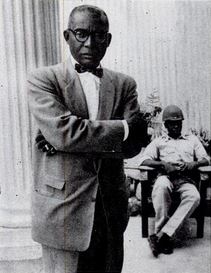
Evil in a bow tie: François Duvalier at the time of the 1957 election campaign. Who would have guessed that this unassuming character would become the worst single Haitian monster of the twentieth century?
Or you can choose not to turn over the briefcase, to let the CIA’s plot take its course. And what happens then? Well, this is how the game describes it…
Smith and Wesson were unable to provide any proof of the CIA’s involvement in Raimone’s killing, and they were censured by Hoover for the accusation.
The following Saturday, Colonel Louis Raimone died from a single rifle shot through the head as he disembarked from a plane in Mexico City. His assassin was never caught, nor was any foreign government ever implicated.
It was estimated that the shot that killed Raimone was fired from a distance of 450 yards, from a Lee Enfield .303 rifle. Very few professionals were capable of that accuracy over that distance; Charles Calthrop was one of the few, and the Lee Enfield was his preferred weapon.
Duvalier didn’t survive long as president. Without the riot equipment that Raimone had been sent to buy, he was unable to put down the waves of unrest that swept the country. The army switched its allegiance to the people, and he was overthrown in March 1958.
Duvalier lived out the rest of his life in exile in Paris, and died in 1964.
Daniel Fignolé returned to govern Haiti after Duvalier was ousted, and introduced an American-style democracy. He served three 5-year terms of office, and was one of Kennedy’s staunchest allies during the Cuban missile crisis. He is still alive today, an elder statesman of Caribbean politics.
His brother’s death having been avenged, Michel Matalas returned to his former job as a stockman in Philadelphia. He joined the army and died in Vietnam in 1968. His nephew, Shibley’s son Mattieu, still lives in Haiti.
David Thomas returned to Haiti in his role as vice-consul, and became head of the CIA’s Caribbean division. He provided much of the intelligence that allowed Kennedy to bluff the Russians during the Cuban missile crisis before returning to take up a senior post at Langley.
What we have here, then, is a question of ends versus means. In the universe of Shades of Gray, at least, carrying out an illegal assassination and interfering in another sovereign country’s domestic politics leads to a better outcome than the more straightforwardly ethical course of abiding by international law.
Ever since it exited World War II as the most powerful country in the world, the United States has been confronted with similar choices time and time again. It’s for this reason that Judith Pintar calls her and her colleagues’ game “a story about American history as much as it is about Haiti.” While its interference in Haiti on this particular occasion does appear to have been limited or nonexistent in our own timeline, we know that the CIA has a long history behind it of operations just like the one described in the game, most of which didn’t work out nearly so well for the countries affected. And we also know that such operations were carried out by people who really, truly believed that their ends did justify their means. What can we do with all of these contradictory facts? Shades of gray indeed.
Of course, Shades of Gray is a thought experiment, not a serious study in geopolitical outcomes. There’s very good reason to question whether the CIA, who saw Daniel Fignolé as a dangerously left-wing leader, would ever have allowed him to assume power once again; having already chosen to interfere in Haitian politics once, a second effort to keep Fignolé out of power would only have been that much easier to justify. (This, one might say, is the slippery slope of interventionism in general.) Even had he regained and subsequently maintained his grip on the presidency, there’s reason to question whether Fignolé would really have become the mechanism by which true democracy finally came to Haiti. The list of Haitian leaders who once seemed similarly promising, only to disappoint horribly, is long; it includes on it that arguably greatest Haitian monster of all, the mild-mannered country doctor named François Duvalier, alongside such more recent disappointments as Jean-Bertrand Aristide. Perhaps Haiti’s political problems really are cultural problems, and as such are not amenable to fixing by any one person. Or, as many a stymied would-be reformer has speculated over the years, perhaps there really is just something in the water down there, or a voodoo curse in effect, or… something.
So, Shades of Gray probably won’t help us solve the puzzle of Haiti. It does, however, provide rich food for thought on politics and ethics, on the currents of history and the winds of fate — and it’s a pretty good little text adventure too. Its greatest weakness is the AGT development system that was used to create it, whose flexibility is limited and whose parser leaves much to be desired. “Given a better parser and the removal of some of the more annoying puzzles,” writes veteran interactive-fiction reviewer Carl Muckenhoupt, “this one would easily rate five stars.” I don’t actually find the puzzles all that annoying, but do agree that the game requires a motivated player willing to forgive and sometimes to work around the flaws of its engine. Any player willing to do so, though, will be richly rewarded by this milestone in interactive-fiction history, the most important game in terms of the artistic evolution of the medium to appear between Infocom’s last great burst of formal experiments in 1987 and the appearance of Graham Nelson’s milestone game Curses! in 1993. Few games in all the years of text-adventure history have offered more food for thought than Shades of Gray — a game that refuses to provide incontrovertible answers to the questions it asks, and is all the better for it.
In today’s Haiti, meanwhile, governments change constantly, but nothing ever changes. The most recent election as of this writing saw major, unexplained discrepancies between journalists’ exit polling and the official results, accompanied by the usual spasms of violence in the streets. Devastating earthquakes and hurricanes in recent years have only added to the impression that Haiti labors under some unique curse. On the bright side, however, it has been nearly a decade and a half since the last coup d’etat, which is pretty good by Haitian standards. You’ve got to start somewhere, right?
(Sources: the books Red & Black in Haiti: Radicalism, Conflict, and Political Change 1934-1957, Haiti: The Tumultuous History — From Pearl of the Caribbean to Broken Nation by Philippe Girard, and Haiti: The Aftershocks of History by Laurent Dubois; Life of June 3 1957; Long Beach Press Telegram of October 1 1957. My huge thanks go to Judith Pintar for indulging me with a long conversation about Shades of Gray and other topics. You can read more of our talk elsewhere on this site.
You can download Shades of Gray from the IF Archive. You can play it using the included original interpreter through DOSBox, or, more conveniently, with a modern AGT interpreter such as AGiliTY or — best of all in my opinion — the multi-format Gargoyle.)
Footnotes
| ↑1 | I do know her real name, but don’t believe it has ever been published in connection with Shades of Gray, and therefore don’t feel comfortable “outing” her here. |
|---|
